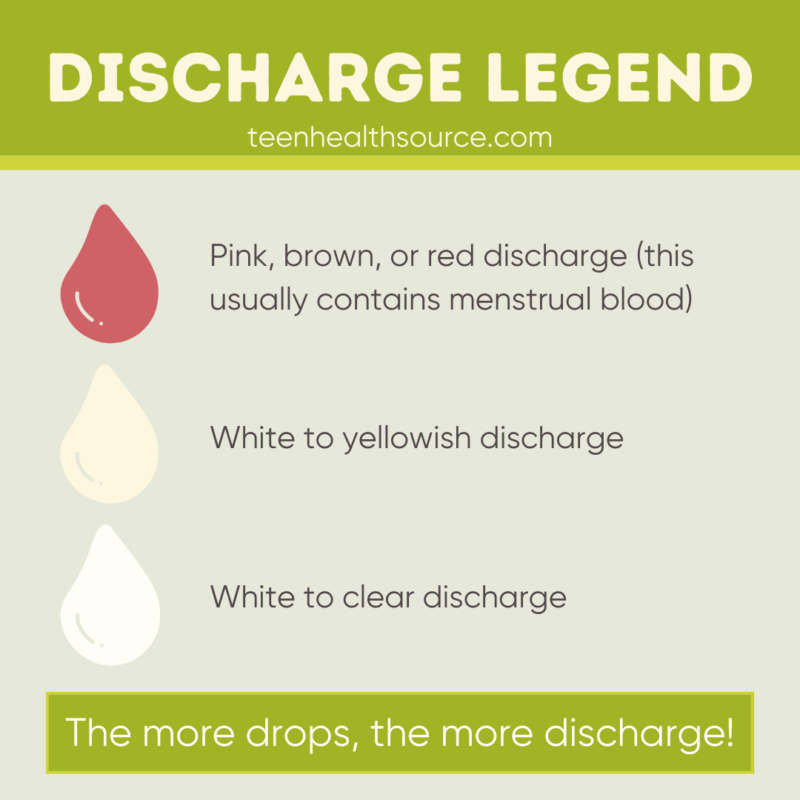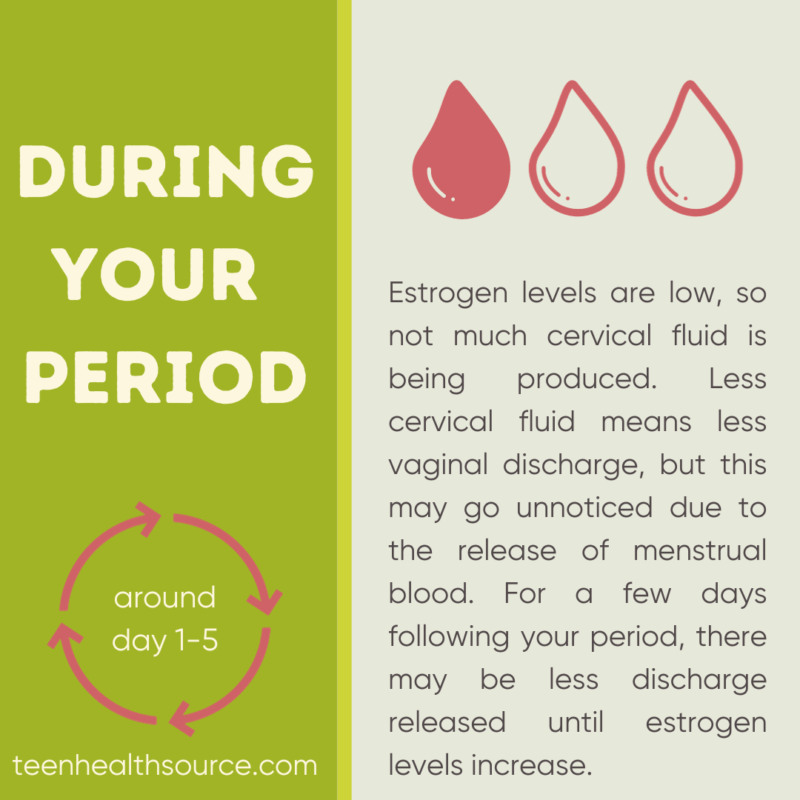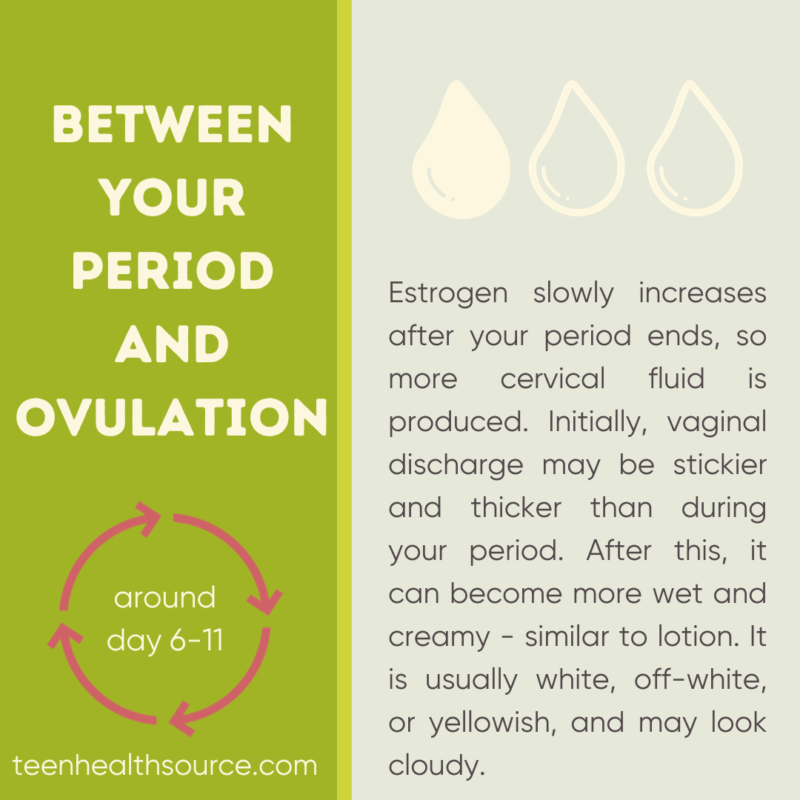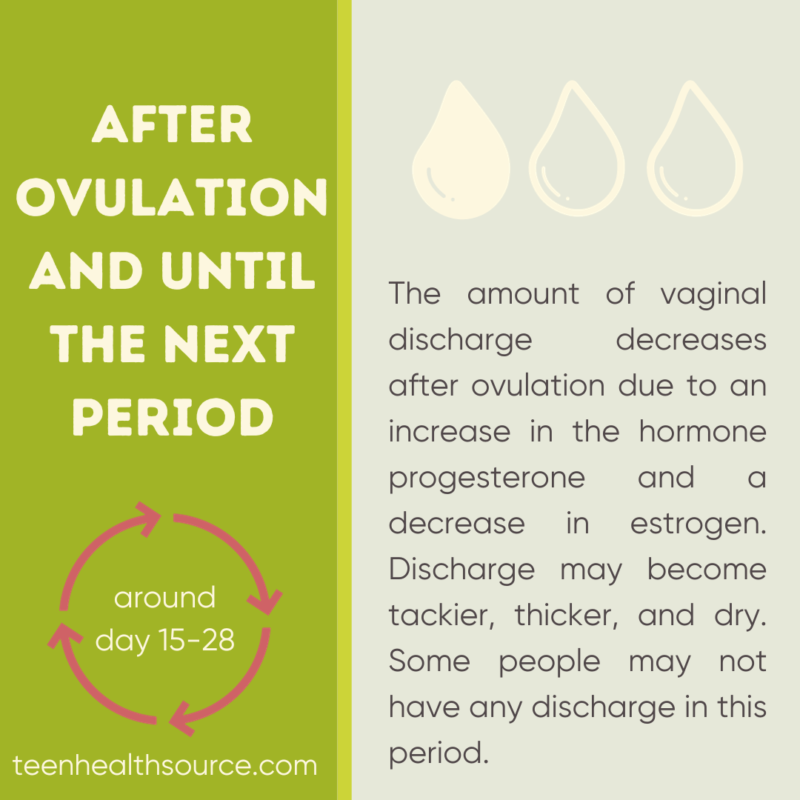Vaginal Discharge
What is vaginal discharge?
People assigned female at birth produce a liquid called discharge that comes out of the vagina. Discharge usually begins to be released around 6 months – 1 year before you’d start menstruation, and continues even after menopause, although at lower levels. It is produced by your vagina and cervix and is made up of cervical fluids (mainly water), shedding cells, and bacteria.
Hormones (mainly estrogen) control how much discharge someone may have, so it is normal to notice a change in amount if you are nearing certain phases of your menstrual cycle, are pregnant/recently gave birth, or if you begin hormonal birth control or a hormonal therapy.
Vaginal discharge may not be noticed until you see it in your underwear or on toilet paper when you wipe. It is also normal to notice discharge while it is exiting your body – some people may find it similar in feeling to when menstrual blood exits the vagina. Remember vaginal discharge is completely normal! What it looks and feels like can vary from person to person and even change within someone’s menstrual cycle.
Monitoring your discharge can help you understand your menstrual cycle, and because certain changes in your discharge may be associated with infection or other health issues, taking note of anything odd or just different than normal can be a good way to stay on top of your vaginal health.
Why do we make vaginal discharge?
Your vagina requires a unique balance of moisture, pH, and good bacteria for it to function properly. Discharge helps to maintain this balance by fighting off infection and bad bacteria. Discharge also protects the urinary tract from infection! Because vaginal discharge is liquid and is released throughout the day, it helps provide lubrication and helps remove potentially harmful substances from your vagina. Discharge can include old vaginal cells, semen after having sex, arousal fluid, and possibly fluid from an infection.
What does the colour of vaginal discharge mean?
- Clear or white: Vaginal discharge that is clear, pure white, or off-white is considered typical. Discharge tends to dry more yellow, which you may notice on your underwear.
- Yellow, grey, or green: A strong yellow, grey, or green colour in your discharge could be an indication of an infection
- Red or brown: Red and brown discharge usually contains blood and can be related to menstruation, abortion, or pregnancy (implantation bleeding). Following an abortion, discharge can appear red, brown, or even purple to black.
What does the consistency/amount of vaginal discharge mean?
Typical vaginal discharge can range from watery and sticky to thick and gooey. Discharge that is chunky or foamy may mean you have an infection. While the amount of discharge you produce will likely change often, if you’re noticing an unusually large increase it may be the result of an infection or other type of irritation.
What does the odour of vaginal discharge mean?
Vaginal discharge usually has an odour, like all bodily secretions, but it should not be strong enough to be unpleasant. A mild odour that isn’t “fishy” or “metallic” is normal. Some things may affect how it smells like urine or blood (depending on the time of your period), or if you’ve recently had an abortion (which may make it more sour). Usually strong or foul odours are a sign that you might have an infection.
What causes irregular vaginal discharge?
- Bacterial vaginosis (BV) is the most common cause of irregular vaginal discharge. Greyish, foul smelling discharge is a sign of BV. BV may go away by itself, but it is often a recurring issue, so seeking treatment is a good idea. Prescription antibiotics are the most effective treatment for BV.
- Yeast infections can cause your discharge to become thicker, with a cottage cheese-like texture. Over-the-counter yeast infection treatments are available. If symptoms do not reside, you should reach out to a healthcare provider.
- Trichomoniasis is an STI caused by a parasite. This STI can turn discharge greenish-grey and/or bubbly and frothy.
- Chlamydia and gonorrhoea are other common STIs that can cause irregular discharge. If your discharge is green, yellow, cloudy or has a strong odour, you may have one of these STIS, and you should reach out to a healthcare provider. *Note that many STIs can be asymptomatic. If you are sexually active, regular STI testing is a good option.
- Other non infection reasons for irregular discharge:
- Objects left in a vagina for too long (e.g. a tampon)
- Irritation or reaction to sexual lubricants, condoms, sex toys, and soaps
- Sexual activity, especially with a new partner.
- Rarely, gynaecologic cancers can cause abnormal discharge. This is usually accompanied by other symptoms, such as abdominal pain, itching and pain of the vulva, and changes in skin colour.
| Remember |
| If you think you may have signs of an infection or are not on (or nearing) your period and are experiencing red or brown discharge with no other explanation, you may want to reach out to a healthcare provider. Because there are so many things that can contribute to irregular discharge and have similar symptoms, it can be really difficult to self-diagnose even with informational web pages like this. Getting tested or speaking to a medical professional is the only way to know for sure what the cause may be. |
What does typical discharge look like throughout one’s menstrual cycle?
Because everyone has different cycle lengths and ovulation time can vary between cycles, this is only a rough outline of what typical discharge looks like. If you are on hormonal birth control or experiencing other hormonal changes, this outline may not be accurate. Hormonal birth control contains the synthetic hormone progestin, which thickens the cervical fluid, helping to prevent sperm from moving through the cervix. Because of this, you may notice thicker and/or less vaginal discharge.
Tips for maintaining regular discharge:
- Try to avoid douching, using scented soaps or bath products (such as bath bombs), baby wipes, or other scented vaginal products, as they may irritate or throw off the pH balance of your vagina.
- When washing your vagina, consider using just your hands and water. Loofahs and washcloths can harbour bacteria that once inside your vagina, can irritate it or throw off its pH.
- Try to limit how long you wear tight underwear or sweaty clothes, and consider not wearing underwear or tight pants to sleep. Your vagina needs to breathe! And avoiding clothes that could trap moisture can be a good way to limit bacteria and yeast buildup. Remember for underwear, breathable cotton is best!
- Try not to wear pads or liners everyday, they can trap moisture as well leading to similar issues like tight underwear. It may be tempting to wear daily liners to absorb vaginal discharge, but it can actually lead to more discharge over time due to bacteria growth and pH imbalances. If you’re worried about stains, consider using an enzymatic stain remover to help break them down before washing.
- Avoid using period products for longer than the directions say is safe if you can, and only use the lightest level of absorption that you need. Tampons are designed to absorb everything including vaginal discharge designed to expel bad bacteria and neutralise pH, using tampons to absorb discharge can actually make it harder for your vagina to clear out that bacteria and keep itself balanced.
- Always wipe from front to back to keep any faecal bacteria (poop) from entering your vagina, preventing infection.
- Because vaginal discharge is one of the body’s natural cleansing mechanisms, no soap is necessary to maintain vaginal health. If you choose to wash with soap, make sure to only use a mild one outside of the vagina and vulva – where hair grows. It seems counterintuitive, but washing your vagina with soap can actually deplete the amount of good bacteria that keeps your vagina healthy, so the best practice is simply rinsing with water.
What is the difference between vaginal discharge and arousal fluid (“getting wet”)?
There are many fluids released from your vaginal area that can sometimes be mistaken for each other, but they are different products that our bodies make at different times for different reasons. Sexual arousal or sexual excitement causes more blood to flow towards the vagina than usual. Arousal fluid is made by the filtration of blood plasma (the liquid part of the blood), so becoming aroused usually leads to more fluid leaving the vaginal tissues, and entering the vaginal canal.
Research on vaginal ejaculate (cum) is still lacking, but current studies suggest the following:
- Vaginal ejaculate is a fluid that can be released through the urethra. It is produced by glands near the urethra, and is usually thick and white.
- “Squirting” is the release of a different fluid, one that is usually completely clear and made up of a dilute urine product released through the urethra.
- Some people with vaginas release ejaculate and/or squirting fluid, and many do not.
Some people might not experience getting wet for many different reasons, both physiological and psychological. The main cause is low hormone levels that can change for several reasons including: menopause, a recent birth and/or breastfeeding, hormonal birth control, autoimmune conditions, some cancer treatments, and anti-estrogen medications. If you experience a sudden unexplained decrease or total loss of vaginal discharge, you should reach out to a healthcare provider.
Further Reading
- Teen Health Source – Puberty for Female Assigned People
- Teen Health Source – What’s the deal with douching?
- Teen Health Source – Yeast Infections
If you have questions about this topic, feel free to contact one of our peer educators. [Link]
Last edited: September 2023.












